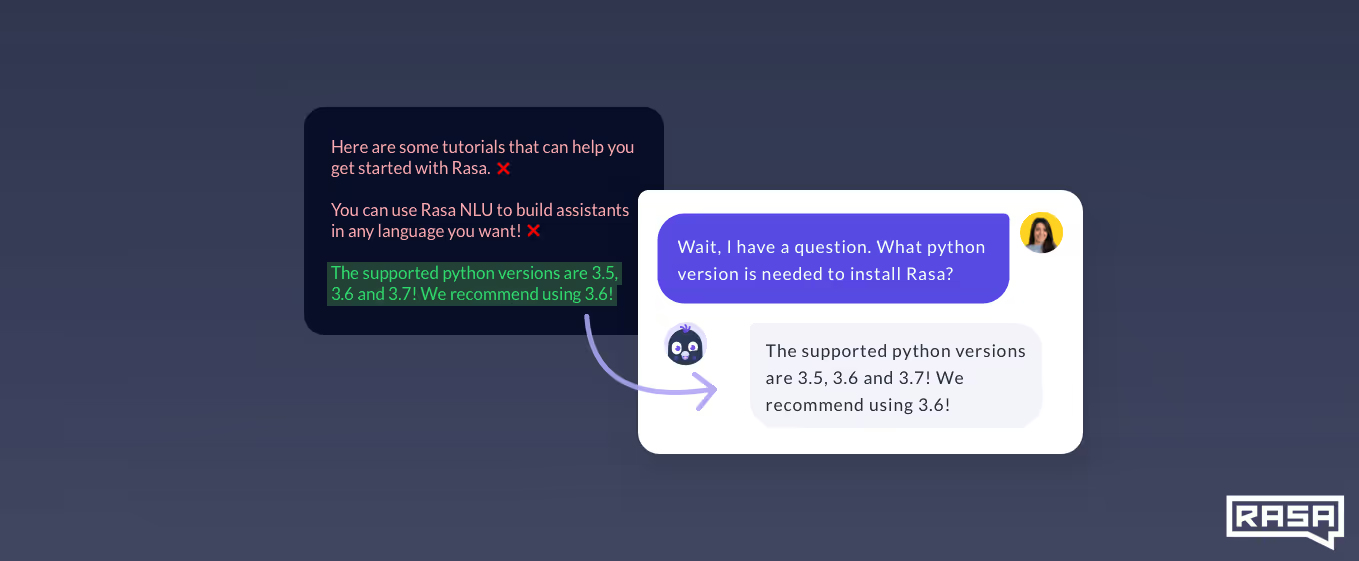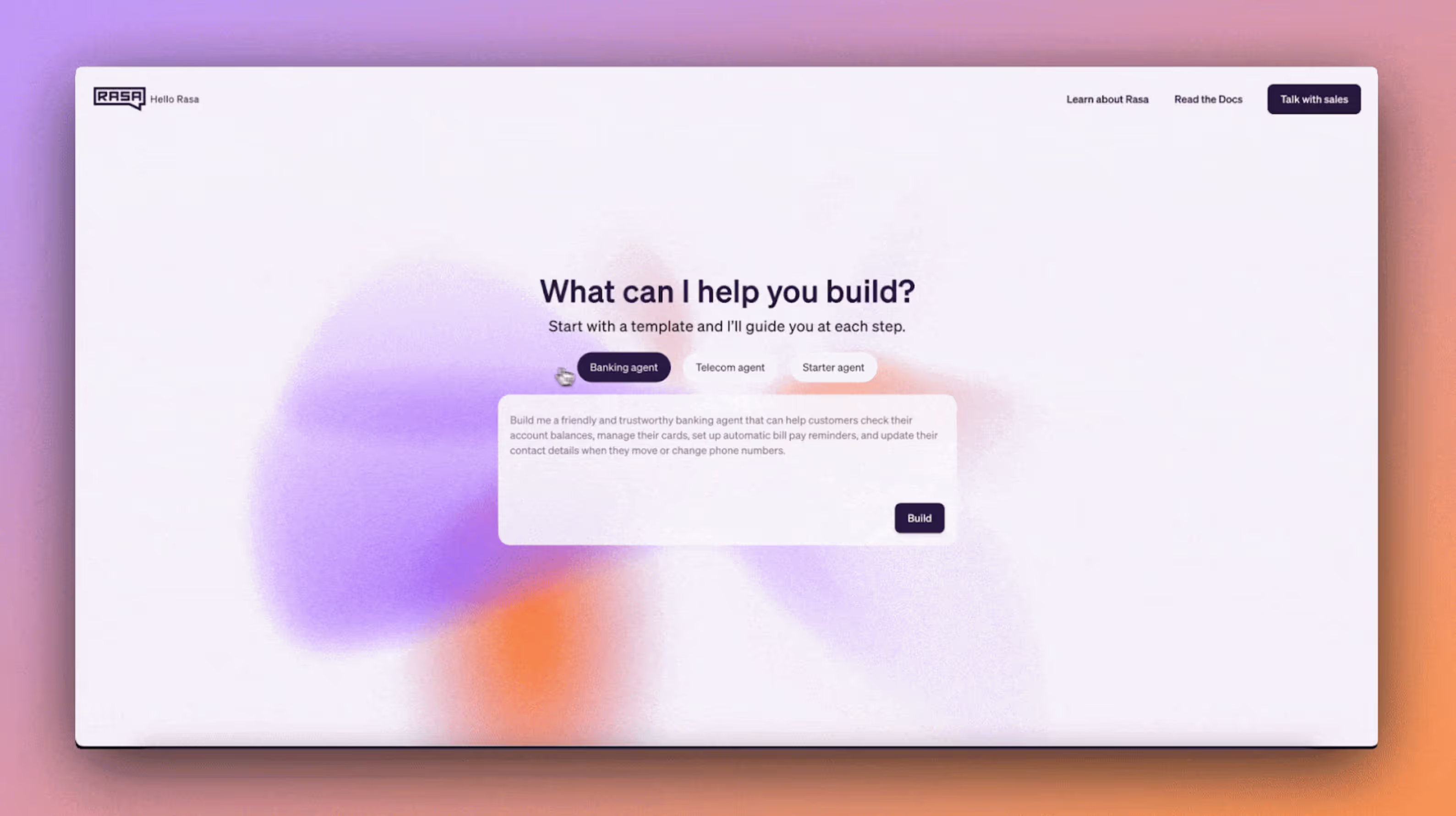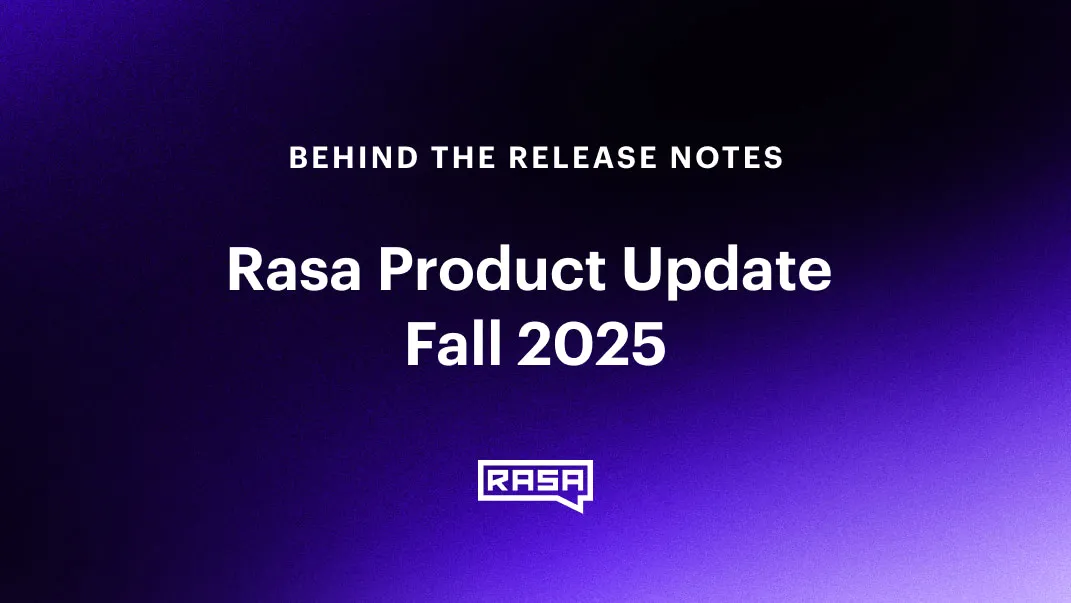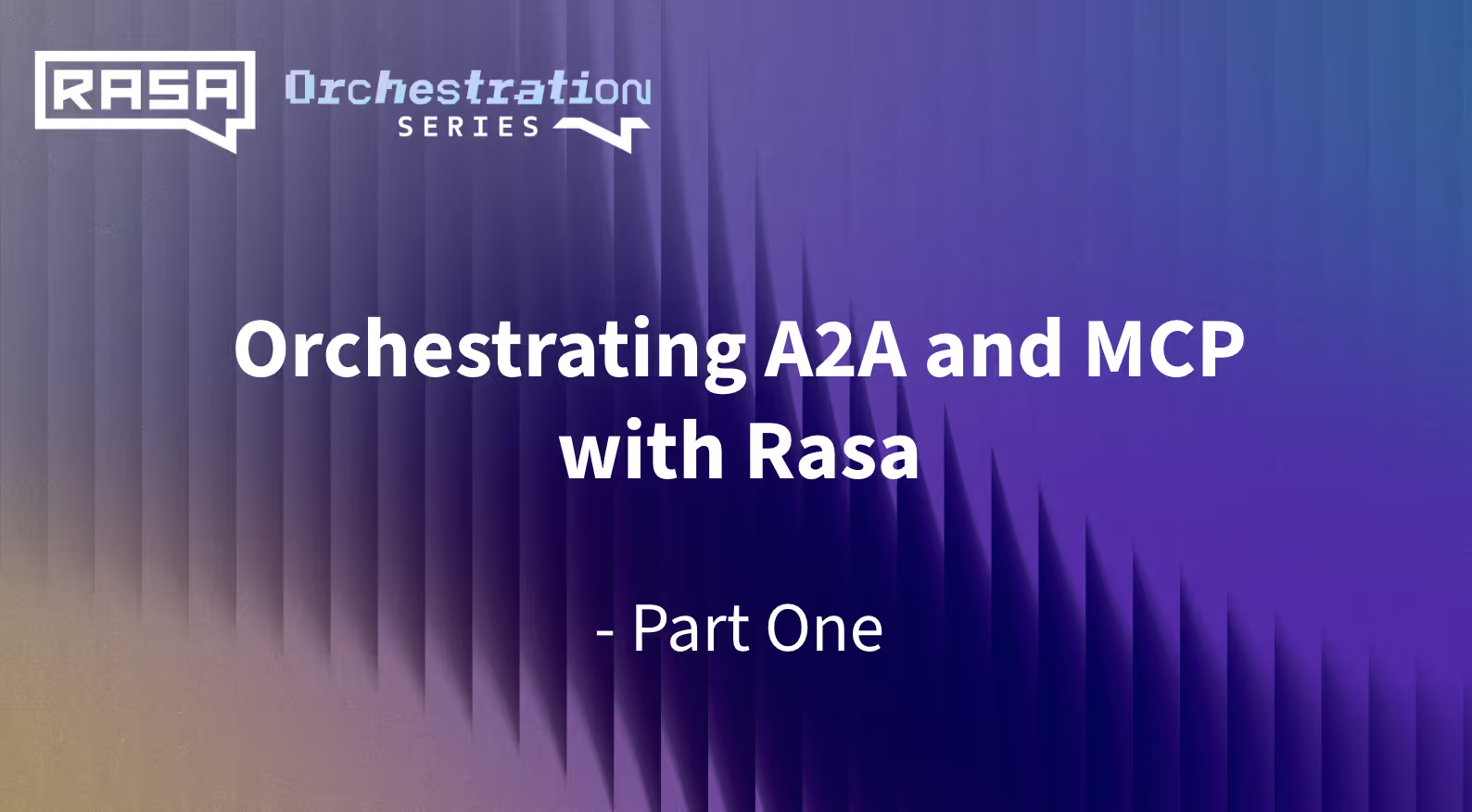In this blogpost, we introduce a new experimental feature that adds retrieval-based response selection to Rasa. Rasa 1.3.0 introduces the Retrieval Action and the ResponseSelector NLU component. Both these components coupled together make it easier to handle specific dialogue elements like small talk,chitchat, FAQ messages, and other single-turn interactions in a simple manner. In short, this blogpost delivers three main ideas:
- Making it easy to handle single-turn interactions within Rasa.
- Defining responses for single-turn interactions as training data, unlike simple utterances in your domain file.
- Building a model to select an appropriate assistant response in single-turn interactions.
Retrieval Actions
Retrieval actions are designed to make it simpler to work with FAQs, chitchat, and other single-turn interactions. By single-turn, we mean that your assistant should always respond the same way, regardless of what happened in previous interactions. Let's take a look at an example conversation:
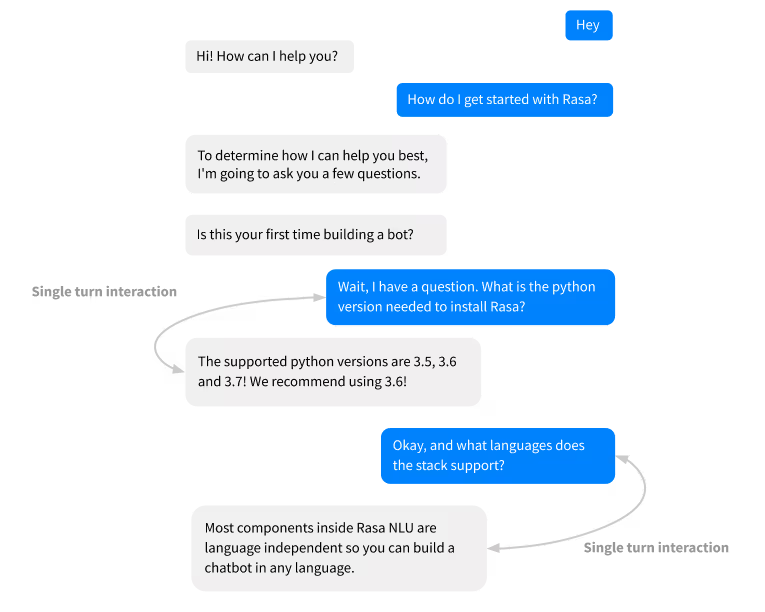
When a user asks Sara (our demo bot) for the recommended python version, Sara should always give the same answer. It doesn't matter what happened earlier in the conversation.
Previously, you had to have a story for every FAQ you want to handle, which would look something like this:
YAMLcopy
## Ask Python version
* ask_faq_python_version
- utter_ask_python_version
## Ask languages supported in Rasa
* ask_faq_languages
- utter_ask_languages
If you use a retrieval action, you just need one story!
YAMLcopy
## Some question from FAQ
* ask_faq
- respond_ask_faq
So what's changed? All FAQ-related intents are grouped into one retrieval intent and are responded to by a single respond_ask_faq action. This makes it easier to treat all FAQ messages in the same manner, with a single retrieval action irrespective of their specific intent.
Since responses to such intents do not depend on previous messages, we do not need a sophisticated core policy to predict the corresponding retrieval action. But since there is a single retrieval action, we need to build a machine learning model to select the most appropriate response from all candidate responses for that action. How do we do that?
Supervised Response Selector
We introduce a new component within NLU called ResponseSelector. The component works by:
- Collecting bag of word features for each user message and candidate response.
- Computing a learnt embedded representation separately for each, by passing the bag of word representations through densely connected layers.
- Applying a similarity function to compute the similarity between user message embedding and candidate response embedding.
- Maximizing similarity between correct user message and response pairs and minimizing the similarity for wrong pairs. This acts as the optimization function for the ML model during training.
- Matching the user message for similarity against all candidate responses at inference time and selecting the response with the highest similarity as the assistant's response to the user message.
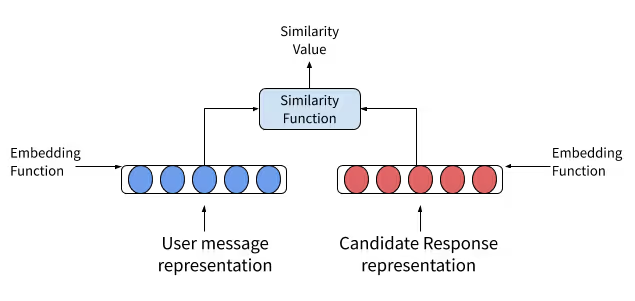
This is very similar to how the EmbeddingIntentClassifier works, with the main difference being that the intent is replaced with the actual text of the response.
The component should be preceded by a tokenizer, featurizer and an intent classifier for it to process the incoming message. You can include the component in your NLU pipeline configuration as:
YAMLcopy
language: "en"
pipeline:
- name: "WhitespaceTokenizer"
- name: "CountVectorsFeaturizer"
- name: "EmbeddingIntentClassifier"
- name: "ResponseSelector"
Training Data
Let's take a look at the training data.
Retrieval Intents
Our retrieval intent ask_faq can have the following NLU examples -
YAMLcopy
## intent: ask_faq/python_version
- What version of python is supported?
- What version of python should I have to install Rasa package?
## intent: ask_faq/languages
- Does Rasa support Chinese?
- What languages does Rasa stack support?
There are two related intents: ask_faq/python_version and ask_faq/languages. The intent classifier will group these intents into a single retrieval intent, ask_faq. Only the ResponseSelector cares about the difference between ask_faq/languages and ask_faq/python_version.
Response Phrases
The actual response texts are now part of the training data, so these will not be in your domain file. This is an important difference between responses for retrieval actions and standard bot responses. Also, since we select a response directly given the user message text, response selection is a step towards end-to-end chatbot training. Hence, we use a response format somewhat similar to the story format used for end-to-end evaluation:
YAMLcopy
## FAQ python version
* ask_faq/python_version
- Rasa currently supports python 3.5, 3.6 and 3.7! We recommend using python 3.6.
## FAQ supported languages
* ask_faq/languages
- Most components inside Rasa NLU are language independent so you can build a chatbot in any language.
It is mandatory to have these response phrases in a separate file (you can call it responses.md, for example) and not in the same file as your NLU training data. The separate file can still be in the same folder containing other data files for NLU training.
Retrieval actions
Rasa uses a naming convention to match the names of retrieval intents like ask_faq to the correct retrieval action. The correct action name in this case is respond_ask_faq. The prefix respond_ is required to identify it as a retrieval action. You should add retrieval actions to your domain file just like any other action. There are two ways to trigger these actions:
- If you always want to just respond and then listen for the next user utterance, use the MappingPolicy to map retrieval intents to corresponding actions in the domain file:
YAMLcopy
intents:
- ask_faq: {triggers: respond_ask_faq}
- If you want specific follow up actions (for example, asking a user if they want tocontinue the flow), include the
respond_ask_faqaction in your stories like anyother action. For example:
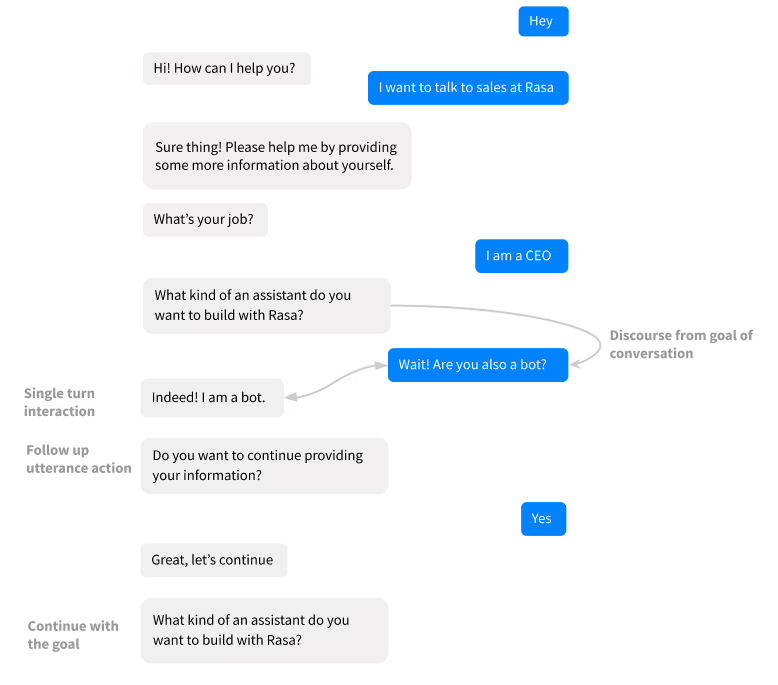
The story for learning the above conversation would look like:
YAMLcopy
* greet
- utter_greet_user
* contact_sales
- utter_moreinformation
- sales_form
- form{"name": "sales_form"}
* ask_faq
- respond_ask_faq
- utter_ask_continue_sales
* affirm
- utter_great
- sales_form
- form{"name": null}
Overall, we tried simplifying the training data format on two primary factors:
- Developer Experience: The training data format should be as intuitive as possible for developers and not extremely different from the existing training data format.
- Logical Sense: All elements of training data should conform to the existing logical constructs of elements inside Rasa -- for example, training data should not be inside the domain file.
Playing a bit more with Response Selector
Rasa allows you to have multiple retrieval intents and correspondingly multiple retrieval actions as part of your assistant. In this case you have two options:
- You can build one shared response selector model which would be trained on user utterance and response utterance pairs across all retrieval intents of your assistant. In this case, you do not need to define the
retrieval_intentparameter in the configuration of the Response Selector: - You can build a specific response selector model for each retrieval intent. Each model would be trained on user utterance and response utterance pairs grouped under that retrieval intent. Hence, the number of response selector components in the NLU configuration should be the same as the number of retrieval intents in the training data. To do this, use the
retrieval_intentparameter in the configuration of each Response Selector component to define the corresponding retrieval intent:
YAMLcopy
pipeline:
- name: ......
- name: "ResponseSelector"
retrieval_intent: ask_faq
...... # other architectural parameters
- name: "ResponseSelector"
retrieval_intent: chitchat
...... # other architectural parameters
The choice between building a specific or a shared response selector model is use-case driven. If utterances in a particular retrieval intent are very domain specific, for example FAQ-related questions, it might not make much sense to learn a shared embedded representation with generic words coming from intents like chitchat and greeting. Your specific model may even perform better with different set of parameters than the ones used for the shared model. For example, the training may improve when using balanced batching as the batching strategy if you have much more data for some FAQs than for others.
We wanted developers to have this flexibility to try and test what works best for them. In our experiments, building a shared response selector model for all retrieval intents yielded similar results when compared to having individual models for each of them. If you observe different results please share them with us on the forum.
Why is the feature experimental?
With the introduction of response selector and retrieval actions, we came up with a new approach to tackle single-turn interactions. The training data format doesn't completely support end-to-end training but is still a step in that direction. Also, the response selector component lies at the intersection of Rasa NLU and Core. Although we believe end-to-end training is an exciting area to progress in, we want to receive enough feedback from the community on the overall developer experience, performance of the model, and the functionality itself before we take it further. Hence, we plan to keep the feature experimental for now. This means that the functionality may be changed or removed based on the feedback we receive.
Conclusion
We now have a completely new way of handling single-turn interactions in Rasa assistants. Also, since the feature is experimental, we encourage you to try it out and give feedback. If you are building bots with this new component or just testing it out, keep us posted on how it goes on the forum. We are excited to see what new interesting use cases you build with this component!
